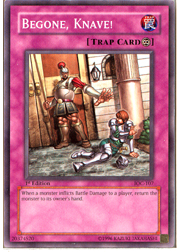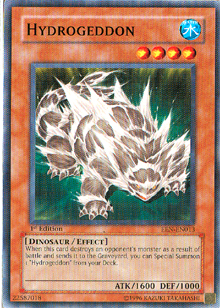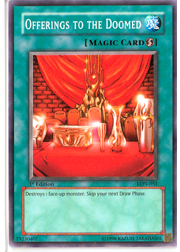 From the commons to the secret rares, the Invasion of Chaos set just screams “power.” Even cards that seem silly at first glance, like Burning Algae, can be absolutely brutal if played in the right deck. The story behind today’s deck goes something like this: I was looking for a way to make Exodia pieces more searchable. I wanted to find a way to make it so that, in addition to using cards like Emissary of the Afterlife, I could also directly search pieces out with Mystic Tomato and somehow bring them into my hand. Preferably, I’d like to do all this without needing to deal with an army of opposing monsters breathing down my neck. Well, long story short, I found what I was looking for in Invasion of Chaos. Begone, Knave! was my card of choice. It made opponents reluctant to attack me while providing options for me to open up their field by ramming my searchers into their monsters. There was also the added bonus of giving me an option to bring on-field Exodia pieces to my hand if only I could attack directly with them. Mystic Tomato would ram into their monsters, replacing itself on the field and bouncing the opposition to hand. Finally, I’d search for an Exodia piece and swing directly, bouncing it to my own hand. If I couldn’t clear the field, I’d just fetch Sangan. All in all, I thought it was a pretty solid idea . . . until I came up with an even better one.
From the commons to the secret rares, the Invasion of Chaos set just screams “power.” Even cards that seem silly at first glance, like Burning Algae, can be absolutely brutal if played in the right deck. The story behind today’s deck goes something like this: I was looking for a way to make Exodia pieces more searchable. I wanted to find a way to make it so that, in addition to using cards like Emissary of the Afterlife, I could also directly search pieces out with Mystic Tomato and somehow bring them into my hand. Preferably, I’d like to do all this without needing to deal with an army of opposing monsters breathing down my neck. Well, long story short, I found what I was looking for in Invasion of Chaos. Begone, Knave! was my card of choice. It made opponents reluctant to attack me while providing options for me to open up their field by ramming my searchers into their monsters. There was also the added bonus of giving me an option to bring on-field Exodia pieces to my hand if only I could attack directly with them. Mystic Tomato would ram into their monsters, replacing itself on the field and bouncing the opposition to hand. Finally, I’d search for an Exodia piece and swing directly, bouncing it to my own hand. If I couldn’t clear the field, I’d just fetch Sangan. All in all, I thought it was a pretty solid idea . . . until I came up with an even better one.
Why go through all the trouble of fetching Exodia pieces and bouncing them back to the hand with Begone, Knave! when I can take advantage of its field clearing properties and just whale on the other guy? Begone, Knave! is a very tricky card. It’s one of those symmetrical effects that rogue deckbuilders are all about using to unimagined effect. First off, why would we want to have a clear field at all times? Well, if the field is clear and any monster that does damage is returned to its owner’s hand, a lot of the popular monsters in today’s game just won’t work. Cyber Dragon doesn’t have any way to be special summoned, Zaborg the Thunder Monarch is pointless, and, in order to play Thestalos the Firestorm Monarch, a player would have to forgo direct attacks in favor of setting more monsters. That may be fine if you have something like Dekoichi that you can flip and then tribute, but that card has been steadily declining in use since people stopped needing Dark attribute monsters in the graveyard. Otherwise, the best bet is to set and not attack with recruiter monsters, which mitigates the threat they usually represent.
Given that all these cards lose a great deal of value while Begone, Knave! is on the field, I needed to create a deck that either doesn’t use them or can create situations where I can use them. I also needed to find a way to maximize the overall benefit of Begone, Knave! After all, what’s the point of building a deck around a card if you don’t have some naughty way of utilizing it? I’d say I was pretty successful. Check out the resulting deck!
“Blue Skies, Open Fields”
Monsters: 20
3 Mystic Tomato
2 Dark Jeroid
3 Don Zaloog
2 Masked Sorcerer
3 Spear Dragon
3 Majestic Mech - Ohka
2 Magical Merchant
1 Sangan
1 Breaker the Magical Warrior
Spells: 9
1 Graceful Charity
1 Pot of Avarice
1 Heavy Storm
1 Nobleman of Crossout
1 Mystical Space Typhoon
1 Premature Burial
3 Offerings to the Doomed
Traps: 11
1 Call of the Haunted
1 Ring of Destruction
1 Mirror Force
2 Reckless Greed
3 Dust Tornado
3 Begone, Knave!
 The goal of this deck is fairly simple. Set Begone, Knave! to the field as quickly as possible to wreak havoc with the opponent’s ability to generate any field presence. It’s been proven time and time again in this format that having monsters on the field is a major factor in winning games. As such, cards like Hydrogeddon have become popular, since they not only punish recruiters and allow for quick offensive strikes, but also allow the player to come back from a bad position by evening out or even reversing the state of the field. Being able to come back from no monsters on field against a Sangan, a spent Dekoichi, and a Cyber Dragon is a good thing, and Hydrogeddon lets you accomplish it. That said, Hydrogeddon is nearly useless once Begone, Knave! hits the field, because even if he or she manages to pull every Hydrogeddon out of the deck, they’ll all get stuck up in the opponent’s hand after they’re done attacking. This gives you a measure of protection against extremely aggressive decks and lets you transform the game into something that most players don’t know how to deal with: a damage race.
The goal of this deck is fairly simple. Set Begone, Knave! to the field as quickly as possible to wreak havoc with the opponent’s ability to generate any field presence. It’s been proven time and time again in this format that having monsters on the field is a major factor in winning games. As such, cards like Hydrogeddon have become popular, since they not only punish recruiters and allow for quick offensive strikes, but also allow the player to come back from a bad position by evening out or even reversing the state of the field. Being able to come back from no monsters on field against a Sangan, a spent Dekoichi, and a Cyber Dragon is a good thing, and Hydrogeddon lets you accomplish it. That said, Hydrogeddon is nearly useless once Begone, Knave! hits the field, because even if he or she manages to pull every Hydrogeddon out of the deck, they’ll all get stuck up in the opponent’s hand after they’re done attacking. This gives you a measure of protection against extremely aggressive decks and lets you transform the game into something that most players don’t know how to deal with: a damage race.
As the name implies, the point of a damage race is to hit your opponent as hard as you possibly can, as fast as you possibly can. To that end this deck is maxed out on Spear Dragon and Majestic Mech - Ohka. Why those two cards in particular? Spear Dragon is the biggest level 4 piercing monster and Ohka is the biggest monster you can normal summon without tributing. Sure, they both have a nasty downside, but that’s where the brilliance of Begone, Knave! shows itself. It doesn’t matter that Spear Dragon switches to defense mode after it attacks, because you’re just going to be picking it back up at the end of the damage step anyway. The fact that Ohka is destroyed at the end of the turn in which you normal summon it without tribute is completely irrelevant if Ohka doesn’t even make it out of the battle phase. Additionally, dropping either of the monsters for a direct swing is no longer a bad idea, because you’ll either draw out one of the opponent’s traps or hit for around a quarter of his or her starting life total and get your monster back to use again next turn. Imagine how ridiculous Breaker the Magical Warrior is when you have Begone, Knave! on the field. The opponent sets a spell or trap, attacks you with a Tomato or something similarly sized, and ends. You summon Breaker, blast the opponent’s trap, then attack for more than the Tomato did to you and get Breaker back in your hand to use again next turn. We’re talking about potentially infinite usage of Breaker in addition to staying ahead in the damage race. Combine that with all the ways you have to make sure the opponent can’t do the same thing to you, and you’ll find it difficult to lose.
Now, there are a couple of cards that can cause some pretty big problems for this deck. Anything that forces my monsters to stay on the field or blocks the attack without destroying the monster is bad for me. With Ohka, an Enemy Controller is as good as a Sakuretsu Armor and Magic Cylinder is as good as a one-sided Ring of Destruction. I’ve included three copies of Dust Tornado in the deck to try to mitigate the risk of the opponent having these cards and also to draw out spell and trap removal while cleverly dropping Begone, Knave! onto the field.
Sometimes, though, the opponent manages to trap you with a monster on the field. Be it a blocked Spear Dragon or a set Magical Merchant, sometimes you have to end with a monster on your side of the field. This opens up the opponent’s ability to special summon Cyber Dragon and another monster that turn. Normally, the end result is that he or she ends with a Cyber Dragon on the field to your nothing, so what should you do? Drop the hammer, harshly and severely. I mentioned that recruiters tend to lose a lot of their charm when they can’t stay on the field or be destroyed in battle. Fortunately, you just know that your opponent is going to do everything in his or her power to keep monsters on the field, and you can use that to your advantage.
First off, let’s take the case where he or she summons something and ends. In fact, just to show you some of the trickery you can get away with thanks to Begone, Knave!, let’s say it’s a Banisher of the Radiance. You flip your Begone, Knave! and then summon Mystic Tomato. You attack with the Tomato into the Banisher. Now what happens? When the Banisher does damage to your Tomato, Begone, Knave! triggers and bounces it back to your opponent’s hand. Then the Tomato is sent to the graveyard and its effect triggers, because Banisher isn’t on the field anymore. This allows you to pull a Don Zaloog or Masked Sorcerer from your deck to either draw a card or strip a card from your opponent while doing damage. Heck, you might even nail the opponent’s Banisher. The Mystic Tomato cards in this deck are to make sure that your opponent’s plays are never the correct ones. One of my favorite plays involved my opponent having a Cyber Dragon and a spent Breaker on the field. I flipped Begone, Knave!, summoned Mystic Tomato, and rammed it into the Dragon. Cyber Dragon bounced to the opponent’s hand, while I fetched Dark Jeroid to lower Breaker’s ATK. I then attacked the Breaker, did a little damage, and Jeroid returned to my hand, to be used next time my opponent thought it would be clever to summon a monster.
 The last thing I want to talk about is the decision to use Offerings to the Doomed and Reckless Greed in the deck instead of things like Bottomless Trap Hole and Sakuretsu Armor. The reason ties back into what I said about turning the game into a damage race. When the goal is to hit your opponent as fast and as hard as you possibly can while reusing your own monsters as much as possible, you can afford to skip a few draw phases if it helps you win faster and more efficiently. I’ve heard many people criticize Ryan Goff’s Third Planet deck because of its callous disregard for draw phases, but much like that deck, this one doesn’t really need them. You’re trying to win as fast as you can, so if you need extra cards right now, Reckless Greed is a great way to get them. If you just need to wreck a Spirit Reaper or a Monarch so that you can get a direct hit through, Offerings to the Doomed is a great way to do that. Remember, the Masked Sorcerer cards are in there in case the skipped draw phases start to become an issue. Don Zaloog can help you put the opponent in a similar situation to your own. The point is, as long as you’re doing more damage than the opponent and Begone, Knave! is still on your field, it really doesn’t matter whether or not you skip a draw or two.
The last thing I want to talk about is the decision to use Offerings to the Doomed and Reckless Greed in the deck instead of things like Bottomless Trap Hole and Sakuretsu Armor. The reason ties back into what I said about turning the game into a damage race. When the goal is to hit your opponent as fast and as hard as you possibly can while reusing your own monsters as much as possible, you can afford to skip a few draw phases if it helps you win faster and more efficiently. I’ve heard many people criticize Ryan Goff’s Third Planet deck because of its callous disregard for draw phases, but much like that deck, this one doesn’t really need them. You’re trying to win as fast as you can, so if you need extra cards right now, Reckless Greed is a great way to get them. If you just need to wreck a Spirit Reaper or a Monarch so that you can get a direct hit through, Offerings to the Doomed is a great way to do that. Remember, the Masked Sorcerer cards are in there in case the skipped draw phases start to become an issue. Don Zaloog can help you put the opponent in a similar situation to your own. The point is, as long as you’re doing more damage than the opponent and Begone, Knave! is still on your field, it really doesn’t matter whether or not you skip a draw or two.
This is a good deck to play if you’re looking to expand your skill set beyond the simple card counting that many “virtual pros” like to shove down our throats. It’s also a blast to play and, really, that’s the important part. I’ll see you over in the School of Duel. Until next time, play hard, play fair, and, most importantly, have fun!
Jerome McHale
jcmchale@andrew.cmu.edu
NEXT WEEK: Did you enjoy the Cyberdark Impact Sneak Preview? I know I did, and next week I’ll show you one of the decks that I came up with while watching people play at the event.